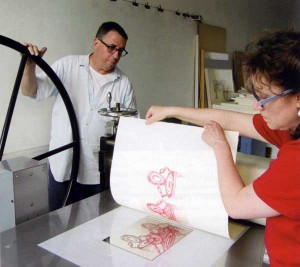For ‘Art on Paper’ Magazine
Felix Harlan and Carol Weaver met as young printers at a print workshop in downtown Manhattan. When it closed, the couple founded their own printshop with a rented press, inherited equipment, and a desire to push traditional techniques to meet the needs of contemporary artists. Now celebrating its twentieth anniversary, Harlan & Weaver is a well-respected, specialty workshop where some of the best-known young and established contemporary artists make prints, using a variety of intaglio techniques. Art on Paper’s Merrily Kerr talked with the couple in their bustling studio.
MK – How did you start out in printmaking?
FH – We met each other in 1980 in New York at Aeropress, which was run by Patricia Branstead. She had been Kathan Brown’s assistant at Crown Point Press in Berkeley, California and brought some of Crown Point’s techniques and professionalism to New York printmaking.
CW – Crown Point Press’s method, was to use standard etching techniques but keep the process contemporary by eliminating preconceived ideas.
MK – What was it like when you went out on your own?
FH – In the beginning, we rented a press, and also printed with Jeryl Parker, who was doing work for Parasol Press, including big prints by Donald Sultan. Jeryl would approach problems with a different kind of thinking, sometimes doing the exact opposite of what most people would do. Even the way he designed his aquatint box, which we now have, was unusual. When we moved here, it was with his equipment, which was a big boost. Working with Jeryl was kind of a bridge. Then we began to get jobs ourselves, and the business took hold, despite a downturn in the market.
MK – The market is strong now. How are things different?
FH – It’s a very productive time in printmaking in general in New York, particularly for etching. There are more possibilities now to publish and to show graphic work. Also, the potential of small letterpress, etching or litho shops is finally being realized. It used to be that printshops had to be large and offer every technique possible. There has also been a shift in taste on the part of people who are buying prints and in curatorial interest in specialized shops. Being a part of that shift, we feel a kinship with a lot of other printers in New York and around the country.
MK – At the same time, you’re a fixture on the Lower East Side.
FH – Twenty years ago, when we went out to look for a studio, the only space we could find in our price range was on the Lower East Side and it was small.
CW – At the time, we were friends with several artists who showed in East Village galleries, and they introduced us to the area and to other artists.
FH – In fact, back then, we met James Siena, who has been doing engravings with us for ten years, because he’s a neighbor in the building. He introduced us to Steve DiBenedetto and Michele Segre, so now we’re working with them. We mostly work with artists who live and work in the New York area, who can drop in and do something and then see it printed a few days later and do more work the week after.
CW – We have also stayed here because we were able to expand within the building, and because artists like the space, which has good natural light.
MK – What’s unique about the shop’s abilities?
CW – When we were younger, we strove to learn all the techniques. We were fortunate to have worked with some painters who wanted to do multi-plate color prints – technically challenging work.
FH – But we’ve continued to use fairly traditional techniques, which we customize according to what the artist wants. We rarely use photo processes or a lot of handwork after printing. The emphasis in this shop is on what you can do with the platemaking – how to alter the metal and then print in a very straightforward way.
CW – We believe that etching is versatile within every technique, whether aquatint, hard ground, or engraving. There is a myriad of ways of approaching etching, and we want to keep all the options open.
MK – Do you work with equal numbers of returning and new artists?
FH – I know there is an emphasis now on working with artists who haven’t been published before. There is a certain cachet about doing the first print, but I don’t think it’s all that important. I’m happy to work with an artist who has done a lot of prints and can bring that experience to the studio.
CW – We enjoy working with artists, young or old, over a period of time. There are artists who have returned many times, including Kiki Smith, Richard Artschwager and Louise Bourgeois. We published prints by Louise and Kiki for the first time in 1999, and we continue to work with both of them frequently.
MK – What will the next twenty years bring?
CW – We’ve always done contract work, but have more recently begun publishing more, which is where we hope we’re headed in the future.